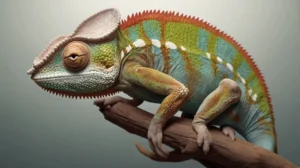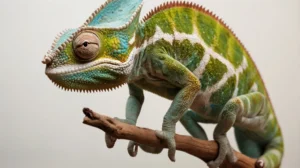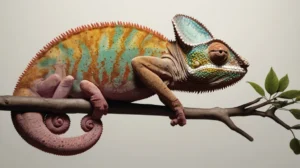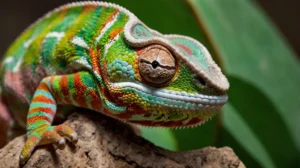Chameleon Medical Information & Health Guide
Understanding Chameleon Health
Chameleons are fascinating but delicate reptiles requiring specific care. Their health is closely tied to their environment, diet, and stress levels. Recognizing illness early is vital due to their ability to hide symptoms. This guide offers general information and is NOT a substitute for professional veterinary care. Always consult an experienced reptile veterinarian for health issues.
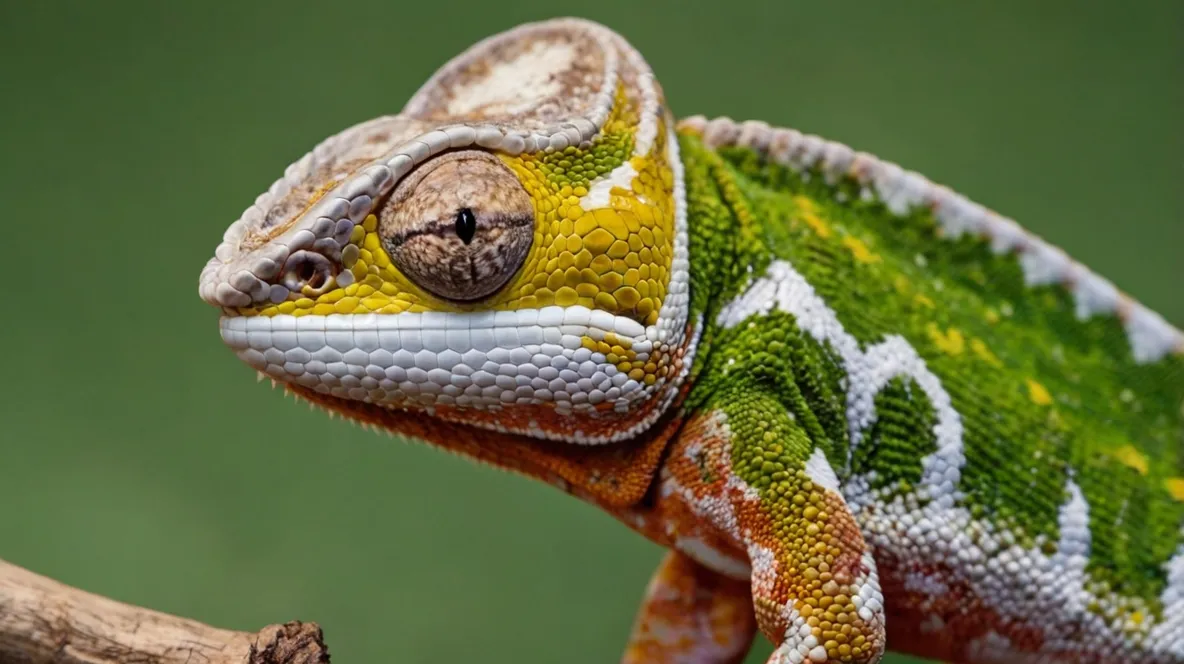
Common Chameleon Health Issues
Awareness of potential problems helps in early detection.
- Metabolic Bone Disease (MBD): Very common due to improper calcium/phosphorus ratio, lack of Vitamin D3 (from UVB or supplements), or incorrect temperatures. Chameleons have high calcium needs.
- Symptoms: Weak bones (bendy limbs), rubbery jaw, kinks in spine/tail, decreased grip strength, lethargy, difficulty shooting tongue, tremors, seizures.
- Prevention: Correct calcium/D3 dusting schedule (species and age-specific), appropriate full-spectrum UVB lighting (replace bulbs regularly), proper basking temperatures.
- Note: Requires immediate vet attention. Damage can be permanent.
- Vitamin A Deficiency (Hypovitaminosis A): Often due to poor supplementation (using beta-carotene instead of preformed Vitamin A) or inadequate gut-loading of feeders.
- Symptoms: Swollen eyes, eye discharge, difficulty opening eyes, respiratory issues, shedding problems (dysecdysis), decreased tongue function.
- Prevention: Use a multivitamin containing preformed Vitamin A (Retinyl Palmitate/Acetate) sparingly, gut-load insects properly. Avoid over-supplementation.
- Note: Must be diagnosed and treated by a vet, often with Vitamin A injections.
- Respiratory Infections (RI): Caused by incorrect temperatures (especially too cold at night), improper humidity, poor ventilation, or stress.
- Symptoms: Gaping/open-mouth breathing, wheezing, clicking sounds, nasal discharge, bubbly saliva, lethargy, decreased appetite, often holding head up high.
- Prevention: Maintain correct day/night temperature gradients, ensure adequate ventilation (screen cages often preferred), avoid drafts, maintain appropriate humidity (avoid stagnant wet conditions).
- Note: Needs prompt veterinary diagnosis and antibiotic treatment.
- Dehydration: Chameleons primarily drink moving water droplets and can easily become dehydrated if their water source isn’t recognized or sufficient.
- Symptoms: Sunken eyes, lethargy, dry/wrinkled skin (check skin turgor), constipation, chalky urates (instead of white/orange).
- Prevention: Provide a dripping system or misting several times daily, ensure chameleon is seen drinking, sometimes hand-watering with a dropper is needed. Ensure proper humidity.
- Note: Severe dehydration needs vet intervention (subcutaneous fluids).
- Stress: Chameleons are easily stressed by improper handling, poor setup (lack of hiding places/foliage), seeing their reflection, presence of other pets, or incorrect temperatures/lighting.
- Symptoms: Dark/dull colors, constant hiding, pacing, loss of appetite, lowered immune system leading to other illnesses.
- Prevention: Provide a large, well-planted enclosure with hiding spots, minimize handling, ensure cage isn’t in high-traffic area, cover reflective surfaces if needed, maintain optimal husbandry.
- Parasites: Internal (worms, protozoa) and external (mites – less common than in snakes). Stress and poor husbandry increase susceptibility.
- Symptoms (Internal): Weight loss, lethargy, abnormal feces, anorexia.
- Symptoms (External): Visible mites (rare), skin irritation.
- Prevention: Quarantine new animals, maintain hygiene, buy captive-bred from reputable sources.
- Note: Requires vet diagnosis (fecal exam) and specific medication.
- Edema/Gular Edema: Swelling, often in the throat/gular region. Can be linked to over-supplementation (esp. Vit D3), kidney issues, or infection.
- Symptoms: Visible puffiness/swelling under the chin or elsewhere.
- Prevention: Correct supplementation schedule, proper hydration, good husbandry.
- Note: Requires immediate veterinary diagnosis to determine the underlying cause.
Preventative Care is Crucial
Proactive measures are the best defense against chameleon health problems.

- Precise Husbandry: Accurate temperature gradients (basking spot, ambient, night drop), species-specific humidity, appropriate UVB lighting (correct type and placement), and excellent ventilation are non-negotiable.
- Proper Hydration: Ensure a reliable dripping or misting system is functioning and observed being used.
- Correct Supplementation: Follow a careful schedule for calcium (with/without D3) and multivitamins (with preformed Vit A). Dust feeders appropriately. Gut-load insects well.
- Adequate Enclosure: Provide a large, predominantly screen enclosure (for most common species) with dense foliage for security and climbing.
- Minimize Stress: Limit handling, provide visual barriers, place enclosure in a calm location.
- Quarantine: Isolate new chameleons for a minimum of 60-90 days.
- Observation: Daily checks for activity, colouration, eating, drinking, feces, and overall appearance are essential.
General Signs of Illness in Chameleons
Watch for these subtle and overt signs that your chameleon needs veterinary help:
- Consistently dark or dull coloration (not related to temperature/mood)
- Sunken eyes
- Decreased appetite or refusal to eat/drink
- Weight loss, visible ribs or hip bones
- Lethargy, excessive sleeping during the day, inability to grip branches
- Weakness in limbs, trembling, difficulty moving
- Swollen limbs, jaw, or throat (gular edema)
- Abnormal feces or lack of defecation
- Discharge from eyes, nose, or mouth; bubbly saliva
- Gaping, open-mouth breathing, wheezing
- Difficulty shedding (dysecdysis)
- Visible lumps, bumps, or sores
Finding an Experienced Chameleon Vet
Chameleons require vets with specific knowledge. Not all reptile vets are equally experienced with chameleons.
- Seek Expertise: Look for vets who explicitly state experience with chameleons or advanced reptile medicine.
- Ask Pointed Questions: Inquire about their familiarity with MBD, Vitamin A issues, and common chameleon ailments. How many chameleons do they see regularly?
- Check Resources: ARAV (Association of Reptilian and Amphibian Veterinarians) can be a starting point, but local reptile groups or breeders may have more specific recommendations.
- Establish Care Early: Don’t wait for an emergency. Schedule a new pet wellness exam.
Act Immediately: Chameleons can deteriorate very rapidly. If you notice any potential signs of illness, contact a qualified reptile veterinarian without delay. Early diagnosis and treatment are critical for survival.

